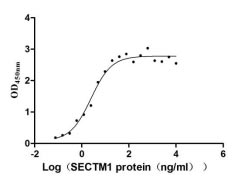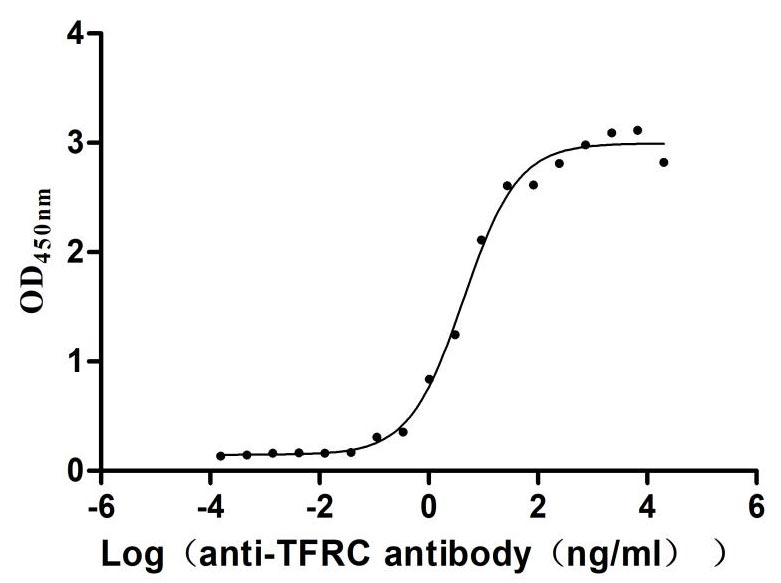Recombinant Human Otoferlin (OTOF), partial
-
货号:CSB-YP017272HU
-
规格:
-
来源:Yeast
-
其他:
-
货号:CSB-EP017272HU-B
-
规格:
-
来源:E.coli
-
共轭:Avi-tag Biotinylated
E. coli biotin ligase (BirA) is highly specific in covalently attaching biotin to the 15 amino acid AviTag peptide. This recombinant protein was biotinylated in vivo by AviTag-BirA technology, which method is BriA catalyzes amide linkage between the biotin and the specific lysine of the AviTag.
-
其他:
-
货号:CSB-BP017272HU
-
规格:
-
来源:Baculovirus
-
其他:
-
货号:CSB-MP017272HU
-
规格:
-
来源:Mammalian cell
-
其他:
产品详情
-
纯度:>85% (SDS-PAGE)
-
基因名:
-
Uniprot No.:
-
别名:AUNB1; Deafness, autosomal recessive 9; DFNB6; DFNB9; Fer 1 like protein 2; Fer-1-like protein 2; FER1L2; NSRD9; Otof; OTOF_HUMAN; Otoferlin
-
种属:Homo sapiens (Human)
-
蛋白长度:Partial
-
蛋白标签:Tag type will be determined during the manufacturing process.
The tag type will be determined during production process. If you have specified tag type, please tell us and we will develop the specified tag preferentially. -
产品提供形式:Lyophilized powder
Note: We will preferentially ship the format that we have in stock, however, if you have any special requirement for the format, please remark your requirement when placing the order, we will prepare according to your demand. -
复溶:We recommend that this vial be briefly centrifuged prior to opening to bring the contents to the bottom. Please reconstitute protein in deionized sterile water to a concentration of 0.1-1.0 mg/mL.We recommend to add 5-50% of glycerol (final concentration) and aliquot for long-term storage at -20℃/-80℃. Our default final concentration of glycerol is 50%. Customers could use it as reference.
-
储存条件:Store at -20°C/-80°C upon receipt, aliquoting is necessary for mutiple use. Avoid repeated freeze-thaw cycles.
-
保质期:The shelf life is related to many factors, storage state, buffer ingredients, storage temperature and the stability of the protein itself.
Generally, the shelf life of liquid form is 6 months at -20°C/-80°C. The shelf life of lyophilized form is 12 months at -20°C/-80°C. -
货期:Delivery time may differ from different purchasing way or location, please kindly consult your local distributors for specific delivery time.Note: All of our proteins are default shipped with normal blue ice packs, if you request to ship with dry ice, please communicate with us in advance and extra fees will be charged.
-
注意事项:Repeated freezing and thawing is not recommended. Store working aliquots at 4°C for up to one week.
-
Datasheet :Please contact us to get it.
相关产品
靶点详情
-
功能:Key calcium ion sensor involved in the Ca(2+)-triggered synaptic vesicle-plasma membrane fusion and in the control of neurotransmitter release at these output synapses. Interacts in a calcium-dependent manner to the presynaptic SNARE proteins at ribbon synapses of cochlear inner hair cells (IHCs) to trigger exocytosis of neurotransmitter. Also essential to synaptic exocytosis in immature outer hair cells (OHCs). May also play a role within the recycling of endosomes.
-
基因功能参考文献:
- two mutations-c.5098G > C (p.Glu1700Gln) and c.1702C > T (p.Arg568Trp)-in the OTOF gene were found to be correlated with ANSD. PMID: 30368385
- ConclusionOur findings implicate OTOF as a potential major contributor to hearing loss in the Saudi population, while highlighting the low contribution of GJB2, thus offering important considerations for clinical testing strategies for Saudi patients. PMID: 29048421
- This study suggested considerable genetic heterogeneity in the causation of hearing loss in Dhadkai. Recessive mutations were observed in at least three genes causing hearing loss: OTOF (p.R708X), SLC26A4 (p.Y556X) and CLDN14 (p.V85D). Mutation p.R708X appeared to be the major cause of hearing impairment in Dhadkai. PMID: 29434063
- Although both otoferlin and synaptotagmin bind membrane fusion SNARE proteins, only otoferlin interacts with the L-type calcium channel Cav1.3. PMID: 28696301
- three unrelated 2 to 6 year-old children who were diagnosed as auditory neuropathy patients who complained of severe hearing loss when they had fever had otoferlin (OTOF) homozygous or compound heterozygous mutations with the genotypes c.2975_2978delAG/c.4819C>T, c.4819C>T/c.4819C>T, or c.2382_2383delC/c.1621G>A PMID: 26778470
- The s conclude that the TRC40 pathway is critical for hearing and propose that otoferlin is an essential substrate of this pathway in hair cells. PMID: 27458190
- In Otof(I515T/I515T) inner hair cells (IHCs), otoferlin levels are diminished by 65%, synaptic vesicles are enlarged, and exocytosis during prolonged stimulation is strongly reduced indicating that otoferlin is critical for the reformation of properly sized and fusion-competent synaptic vesicles. PMID: 27729456
- Our results confirmed that mutations in OTOF gene were a major cause of congenital Auditory neuropathy spectrum disorder (ANSD) in China. Identification of OTOF mutations can facilitate diagnosis, clinical intervention and counseling for congenital ANSD PMID: 26818607
- findings suggest that the mutation found in C2C domain of the OTOF gene is likely to cause deafness in the studied family reflecting the importance of C2 domains of otoferlin in hearing loss PMID: 27652356
- Two mutations in the otoferlin gene, nonsense mutation p.R425X, contributes to a premature stop codon, may result in a truncated polypeptide, which strongly suggests its pathogenicity for auditory neuropathy spectrum disorder. The missense mutation p.L1665P results in a single amino acid substitution in a highly conserved region. PMID: 28335750
- Mutations in RAI1, OTOF, and SLC26A4 may have roles in nonsyndromic hearing loss in Altaian families in Siberia PMID: 27082237
- Our observation of the discordant audiologic phenotype within the same DFNB9 family is more likely due to the loss of OAE over time rather than a genotype-phenotype correlation. PMID: 24814232
- audiological phenotype associated with different OTOF mutations appears to be consistently different suggesting the presence of a genotype-phenotype correlation PMID: 24746455
- The C2F and C2C domains of otoferlin preferentially bind phosphatidylinositol 4,5-bisphosphate (4,5)P2. PMID: 24999532
- We characterize a novel otoferlin mutation discovered in a sibling pair diagnosed with auditory neuropathy spectrum disorder and investigate auditory nerve function through their cochlear implants. PMID: 24135434
- OTOF gene mutataion is found in a Chinese patient with auditory neuropathy spectrum disorder. PMID: 24001616
- The six probable pathogenic variants of OTOF genes were novel: 2 nonsense mutations (p.W717X, p.S1368X) and 4 missense mutations (p.D450E, p.R1583H, p.V1778I, p. E1803A). PMID: 24053799
- The study concludes that OTOF mutations are not the major cause of autosomal recessive nonsyndromic hearing loss in the Iranian population. PMID: 22906306
- nine different mutations of OTOF were detected(seven of them were novel)in Japanese patients with auditory neuropathy PMID: 22575033
- Otoferlin is a multi-C2 domain protein associated with genetic human deafness. It functions in hair-cell exocytosis. Several otoferlin C2 domains bind to Ca2+, phospholipids, & proteins. Review. PMID: 22959777
- OTOF and PJVK gene variants have a role in auditory neuropathy spectrum disorder in Chinese patients PMID: 21935370
- OTOF does not seem to contribute to the pathogenesis of autosomal dominant auditory neuropathy in this family study. PMID: 18035737
- The predominance of the p.E1700Q mutation and the evidence of its founder effect indicate a distinct OTOF mutation spectrum in Taiwanese patients with auditory neuropathy. PMID: 20224275
- The mutatuion screening confirms that the OTOF gene contributes to auditory neuropathy and to termperature-sensitive auditory neuropathy. PMID: 20504331
- Purpose of this paper is to analyse OTOF gene in a series of subjects affected by auditory neuropathy. Genetic analysis identified five new mutations. PMID: 20211493
- This study revealed a novel mutation p.Glu1804del in exon 44 of OTOF. The mutation was found to be homozygous in the three patients and segregated with the temperature-dependent deafness within the family. PMID: 20230791
- Mutations in the OTOF gene are frequent causes of auditory neuropathy in Brazil and our results confirm that they are spread worldwide. PMID: 19461658
- mechano-electrical transduction and cochlear amplification are normal in patients with OTOF mutations. Potentials are consistent with decreased neurotransmitter release resulting in abnormal dendritic activation and impairment of auditory nerve firing. PMID: 19636622
- Q829X, a novel mutation in OTOF, is the third most frequent mutation causing prelingual non-syndromic hearing loss reported so far in the Spanish population. PMID: 12114484
- Substitutions in the conserved Ca-binding C2C domain of otoferlin cause DFNB9, a form of nonsyndromic autosomal recessive deafness. 2 new mutations were found in exon 15 of the long splice form: 490 (Pro > Gln) and 515 (Ile > Thr. PMID: 12127154
- There are uncommon cytidine-homopolymer dimorphisms in 5'-UTR of the human otoferlin gene. PMID: 12469219
- Mutations in the OTOF gene cause a non-syndromic recessive auditory neuropathy. PMID: 12525542
- Mutations in OTOF cause both profound hearing loss and a type of hearing loss where otoacoustic emissions are spared called auditory neuropathy. PMID: 16371502
- Otoferlin is essential for a late step of synaptic vesicle exocytosis and may act as the major Ca(2+) sensor triggering membrane fusion at the auditory inner hair cell ribbon synapse. PMID: 17055430
- Results confirm that mutation of the OTOF gene correlates with a phenotype of prelingual, profound nonsyndromic hearing impairment, and indicate that OTOF mutations are a major cause of inherited auditory neuropathy. PMID: 18381613
- Direct interaction of otoferlin with syntaxin 1A, SNAP-25, and the L-type voltage-gated calcium channel Cav1.3. PMID: 19004828
- we demonstrate the existence of an alternative splice isoform of OTOF expressed in the human cochlea PMID: 19250381
显示更多
收起更多
-
相关疾病:Deafness, autosomal recessive, 9 (DFNB9); Auditory neuropathy, autosomal recessive, 1 (AUNB1)
-
亚细胞定位:Cytoplasmic vesicle, secretory vesicle, synaptic vesicle membrane; Single-pass type II membrane protein. Basolateral cell membrane; Single-pass type II membrane protein. Endoplasmic reticulum membrane; Single-pass type II membrane protein. Golgi apparatus membrane; Single-pass type II membrane protein. Cell junction, synapse, presynaptic cell membrane; Single-pass type II membrane protein. Cell membrane; Single-pass type II membrane protein.
-
蛋白家族:Ferlin family
-
组织特异性:Isoform 1 and isoform 3 are found in adult brain. Isoform 2 is expressed in the fetus and in adult brain, heart, placenta, skeletal muscle and kidney.
-
数据库链接:
HGNC: 8515
OMIM: 601071
KEGG: hsa:9381
STRING: 9606.ENSP00000272371
UniGene: Hs.91608
Most popular with customers
-
Recombinant Human Secreted and transmembrane protein 1 (SECTM1), partial (Active)
Express system: Mammalian cell
Species: Homo sapiens (Human)
-
Recombinant Human C-X-C chemokine receptor type 4 (CXCR4)-VLPs (Active)
Express system: Mammalian cell
Species: Homo sapiens (Human)
-
Recombinant Macaca fascicularis Membrane spanning 4-domains A1 (MS4A1)-VLPs (Active)
Express system: Mammalian cell
Species: Macaca fascicularis (Crab-eating macaque) (Cynomolgus monkey)
-
Recombinant Human Transferrin receptor protein 1 (TFRC), partial (Active)
Express system: Mammalian cell
Species: Homo sapiens (Human)
-
Recombinant Macaca fascicularis Dipeptidase 3(DPEP3) (Active)
Express system: Mammalian cell
Species: Macaca fascicularis (Crab-eating macaque) (Cynomolgus monkey)
-
Recombinant Human C-C chemokine receptor type 5 (CCR5)-VLPs (Active)
Express system: Mammalian cell
Species: Homo sapiens (Human)



-AC1.jpg)














